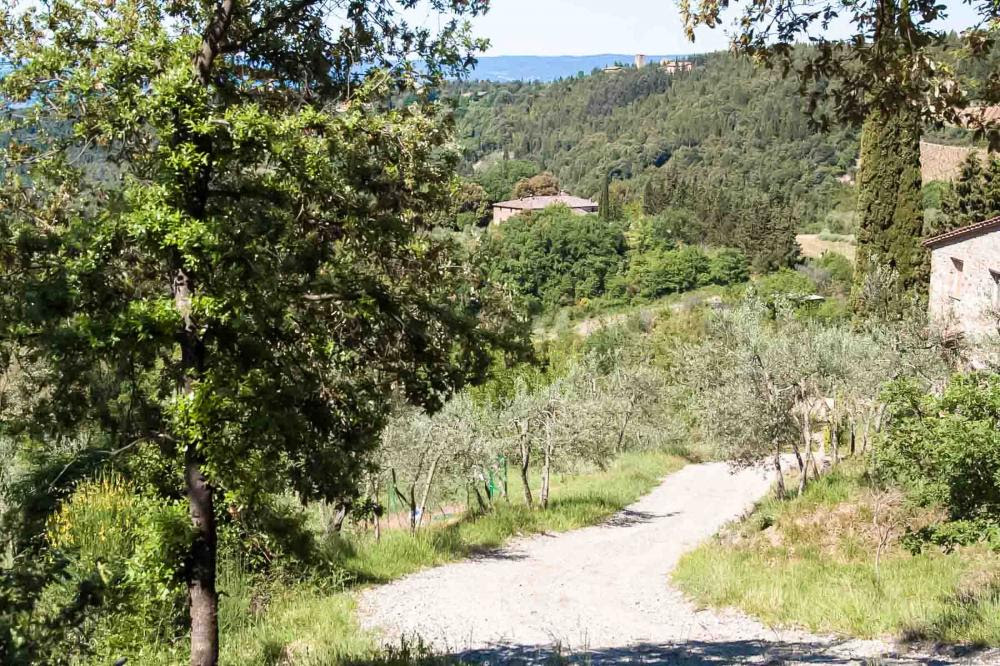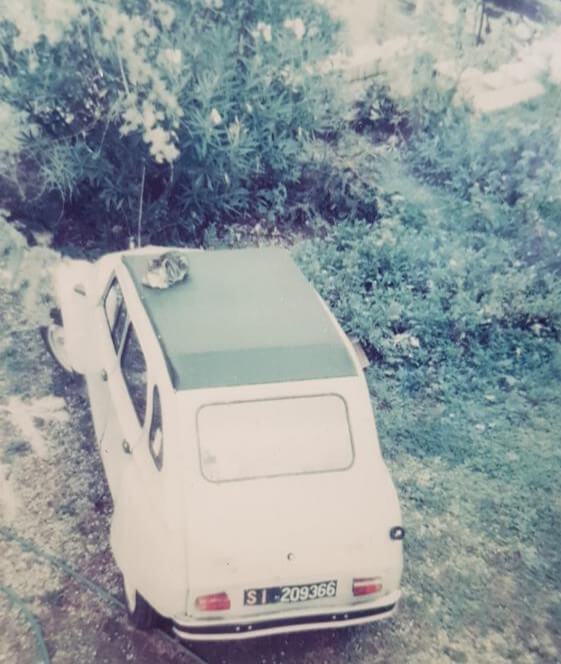Allegro, ma non troppo!
Do you know where Tuscany is?
It’s a region slap bang in the middle of Italy with rolling hills, olive trees, vineyards, fields of hay, churches, palaces, towers and more medieval and renaissance art than any reasonable person would believe possible.
It’s also the place where I grew up.
Spending about half of the year living in the very old house you see at the top of this email, tucked in between the woods and slopes dotted with olive trees and lined by vineyards.
The drive to get to the house from the winding main road was about a mile long, a dirt track with hair-raising bends, rocks sticking out the bottom and random inclines that went down and then up and then down again, following the contours of the hills through the woods and the olive groves.
Visitors were told that we’d collect them at the top of the road if their car was one of those sporty ones with the frame low to the ground; sometimes they wouldn’t listen and they’d get started on the track anyway, only to reverse back up again after the first few bends, white as a sheet.
One lady famously blurted out when she finally got to the bottom of the drive and out of her car, “thank god I’m not pregnant or it would have popped out already!”

Whenever visitors left to go back to their home, my father spent a good while explaining how to tackle the most critical bit when going back up.
“Allegro, ma non troppo!”, Dad used to recommend – a musical instruction meaning “go fast, but not too fast”.
“And whatever you do – just go back down if you get stuck”.
This particularly steep stretch on the track came after a sharp bend and had a bit of a step at the top, before it flattened out again in front of my aunt’s house. It required first gear with a healthy dose of gas, but not too much. If you went too slow, you’d lose momentum and get stuck before you reached the top. On the other hand, if you stepped on it too hard, you would slip and slide on the uneven rocky surface, shifting dirt and pebbles, and you’d also get stuck.
Most people didn’t really listen, thinking they knew how to drive already.
And they were wrong.
That track, and that hill, demanded respect. Once you mastered it, it would always reward you with a successful climb. But you needed to play by its rules.
Us kids would watch the cars leave from the top of our favourite olive tree in trepidation, waging bets on whether this particular guest would be arrogant, and thus punished by the rightful anger of the mighty gods of the track, or humble, and thus rewarded with a triumphant ascent.

I confess: we used to absolutely love it when someone failed to get all the way up.
Giddy with excitement, we’d watch the car come to an abrupt, gravity-defying halt while still metres away from the top – sometimes on the very cusp of it, on that cursed extra step at the summit that had the better of so many seasoned drivers. Who in their hubris thought they could tame that track.
With delighted horror, we’d stare at the stuck car disregarding my father’s clear instructions: furiously stepping on the gas while stationary on that damn slope, with rocks and pebbles and dust darting around in all directions from under the wheels – which were not budging a centimetre. Apoplectic with powerless indignation, like an angry beetle flung on its back, legs in the air, unable to move up any further.
Because the truth was that once you got stuck, the absolute worst thing that you could do was to try and get started again from where you were. No no no no no. The only way to conquer that hill if you got it wrong was to descend it in reverse and start again at the bottom. It was impossible otherwise. Reversing was scary as heck, but truly the only way out was back.
Us kids knew this very well: we’d learned to drive on that track. In a mint green Citröen Dyane.

Really nothing to do with the story but I love it so much so here it is.
Imagine our glee – and the stuck driver’s humiliation – when our father commanded one of us scruffy teenagers to go and rescue the situation. Especially when one of the teenagers was a girl
.
We’d get in their car, barely hiding our glee, we’d niftily reverse it back down, and we’d swiftly get it to climb up – merrily merrily – allegro, ma non troppo.
Ah, the satisfaction.
When to go back and start again
The main life lessons we learnt on that hill were these:
- [The best car to go up a hilly dirt track or a vineyard is a Dyane]
- When you get stuck, the best thing to do is: go back and start again.
The worst thing that happened to those drivers that got stuck on the hill wasn’t the mistake that they made: that’s fairly normal. I also got stuck the first time I attempted the ascent (don’t tell anyone).
It was the fact that they weren’t willing to admit the mistake, go back and start again. They’d used the wrong technique: time to try a different one.
Go back, choose a different method, start again: conquer the climb, hooray hooray, triumph is yours.
This happens to us in technology all. The. Time.
We make a mistake. We use the wrong technology. The wrong technique. The wrong tool. The wrong method.
I can’t even count the times I tried a new tool, spending time building something with it – only to realise I was now stuck – like a car halfway up a steep hill.
I’d worked hard to get to that point – surely it would be best to carry on?
No. Because if you do, all that happens is that stones and pebbles fly everywhere – and you don’t make any progress.
I was reminded of the infamous hill on our drive this week, with one of my clients, an institution with a big image archive. A few years ago, they commissioned the build of a proprietary bespoke content managing system to host their digital archive: a tool that’s used on a daily basis by the institution’s staff as well as by external researchers.
However, something happened with the development along the way. So much so, that that tool is now practically impossible to use. I’ve witnessed the staff try and catalogue some items with it, and it was actually painful to watch.
Stuck like a car halfway up a steep hill.
It was a bespoke tool – we’ve spent money on it – used it for years – we’ve built an archive with it… while it makes the people who try and work with it, tear their own hair out in helpless frustration. Every. Single. Day.
With nowhere to go.
Stuck like a car halfway up a steep hill.
In the meantime, a new, off-the-shelf system has come to the market. It’s so much better, easy to use, complete, supported, open source, and with a database that can be connected to custom fields in WordPress. A member of staff, while working on an external project, has already created a parallel digital archive with it, so most of the work is already done.
Tools come and then they go. You commission a bespoke system, because it’s the best thing that you could do at that time. Then it doesn’t quite turn out as you thought it would. The fact that it’s a proprietary system starts being a burden. The developers are not responsive, and they’re not keeping the system updated.
There is no point carrying on with it. It was good, it was the right thing to spend money on – until it wasn’t anymore. It’s time to acknowledge that there’s nowhere to go from here. That the wheels won’t budge. No progress will be made.
But guess what – we have a great alternative:
Go back down that damn hill and start again!
And this time go back up and do it like you should: allegro, ma non troppo.
This also applies to old projects, and even jobs. Sometimes we keep stepping on the gas just because we think “I’ve got this far already! I can’t go back!”
When in fact we should just reverse back down, and start again – perhaps on a different track, even, or in a different car.
What about you? Are you attached to old technology, old projects, old clients? Do you get stuck on that hill – or do you merrily reverse and then climb up again, allegro ma non troppo?
Let me know how you do it – I’d love to hear.
(Thank you dad, for letting us fly up that hill )
Another example of Deceptive Design
A few weeks ago we were talking about Deceptive Design, i.e. “tricks used in websites and apps that make you do things that you didn’t mean to, like buying or signing up for something.”
I told you that unfortunately Deceptive Design patterns (formerly known as Dark Patterns) are ubiquitous nowadays: so many companies are using them, even the nice ones. And once you start noticing, you just can’t stop.
I use ThriveCart as the payment cart for the products I sell. It’s a great product, and I really like the people who built it. ThriveCart is available as a lifetime deal, which quite frankly is a welcome interruption in the never-ending, ever-growing monthly subscription pattern. After you buy their product, they automatically make you part of their very generous affiliate scheme that gets you 50% of any sale you make. (I’m not adding any affiliate link in here though, not today).
The other day I got an email from ThriveCart, announcing the launch of their new course platform, Learn. I pricked up my ears, because one of the things I have accepted in life is that the course platform you choose serves your purposes, until it doesn’t (see item 1. above!!). Especially if they were to sell it as a lifetime deal.
But Thrivecart went one better!
They’re offering Learn for free to their current Thrivecart customers.
Glee, delight, happiness!
I watched until the end of the video, listening to the narrator extolling the virtues of the platform. Great! I thought. I’ll definitely check it out! Thank you TC, that’s really generous of you.
But then – this page popped up, after the end of the video:

Really, ThriveCart?
Two things are wrong with this in my opinion.
1. Bait and Switch. You spent time in the video waxing lyrical about the virtues of the Learn platform, and you told me it would be mine for free. In all this, you never even hinted at the fact that there’s a Learn+ version that I will definitely need to get in order to have a complete tool – and I will have to pay for it.
Don’t get me wrong: I’m happy to pay for a good product, and I am indeed finding your gift very generous.
But why not tell me in the first video that there’s an upgrade available? The existence of Learn+ came as a complete surprise, in the guise of a sales page for a product I haven’t tested or even seen a demo of yet. There was nothing in the video to make me think that there was a premium version.
Solution: make a brief mention in the video that you’re giving us the basic version as a gift, and we can upgrade to Learn+ if we like it. It’s not that hard, it’s honest, and I still appreciate your gift – only, I don’t get the unpleasant taste in my mouth that you gave me when you made me feel stupid.
In fact, I felt a little bit like the way I did when I plunged blindfolded and fully clothed into a paddling pool.
You could also wait to make the sales pitch until I’ve actually had the chance to see a proper demo of the tool.
2. Confirmshaming. This I didn’t expect from the good people of ThriveCart. Here’s the wording of the option to decline:
“No, I don’t want the most powerful Learn account”
Which is textbook Confirmshaming: “The act of guilting the user into opting into something. The option to decline is worded in such a way as to shame the user into compliance.” I haven’t even had the time to look at the free version yet – and you’re already shaming me for not buying the premium one?
Solution: A simple “No thanks” button will do (even though some argue that even “No thanks” can be perceived as passive aggressive… but that’s a story for another time).
I hope that ThriveCart change their tactics because this is not cool. I do love the product and so far their ethics have been sound.
Have you also watched the video? Do you agree with me?
Let me know what you think.
Also, please do write back with interesting or particularly galling dark patterns that have come your digital way recently. I’d like to make this a regular feature in this newsletter.
The Page Builder Summit is here again!
Another October, another edition of the brilliant Page Builder Summit!
I’m very proud to say that I’ve been a part of the summit since the first edition, and this one is no different: my Cloudways Mavericks colleagues Jan Koch, Lee Jackson and I will give our answers to the burning question “Should Agencies Use Page Builders?” in a panel. Should you decide to buy the PowerPack, you’ll also find my talk on typography from a previous edition in the vault – which will get you a free seat on the Typography 101 course.
You can learn absolutely everything you’d ever want to know about the summit over here, but as a quick overview:
- The summit will run from the 18th to the 22nd of October 2021
- Each day will be packed with amazing speakers, who are ready to help you streamline your process so you can become more efficient and effective, making Page Building easier and quicker
- There’s a pop-up Facebook group where you’ll find accountability buddies, connect with other Page Builders, ask the speakers questions, and whatever else we come up with!
- You can attend the summit absolutely free, but you can also choose to grab the Page Builder PowerPack which will give you access to all the videos forever, but you also get Extra material and Bonus giveaways and special offers of more than $2000.
The links to the summit in here are indeed affiliate links! so you might be buying me my next glass of verdejo at my favourite chiringuito!
Hope to see you at the Page Builder Summit. It’s one of my favourite online conferences of the year.
In case you missed it: I’d say that’s about right

I usually think that this type of meme gets it wrong or stretches it too far – but I have to say, this one did make me chuckle.

